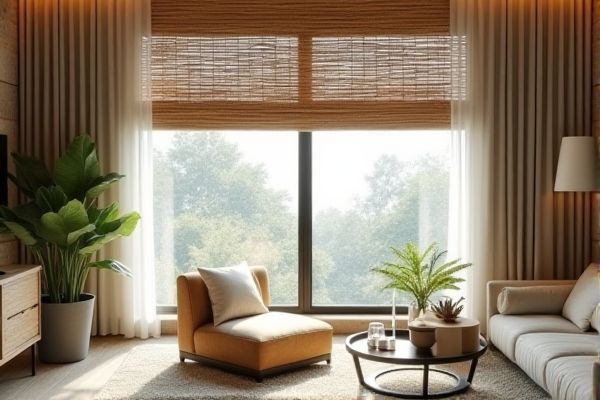
Bamboo blinds offer a natural, eco-friendly option with excellent light control and durability, while fabric curtains provide a softer, more decorative touch with greater variety in colors and patterns to suit any interior style. Discover the pros and cons of each to determine which window treatment best complements your space and lifestyle by reading the rest of this article.
Table of Comparison
| Feature | Bamboo Blinds | Fabric Curtains |
|---|---|---|
| Material | Natural bamboo wood | Various fabrics (cotton, polyester, linen) |
| Light Control | Partial light filtering, adjustable slats | Full to partial coverage, depends on fabric density |
| Durability | High resistance to wear, moisture sensitive | Varies by fabric, generally less durable than bamboo |
| Maintenance | Easy to clean with vacuum or damp cloth | Requires regular washing or dry cleaning |
| Style | Natural, rustic, eco-friendly | Wide range of colors and patterns |
| Installation | Mounts inside or outside window frame | Requires curtain rods and hooks |
| Cost | Moderate price range | Varies widely depending on fabric and design |
| Environmental Impact | Renewable, biodegradable material | Depends on fabric production and dyes used |
Introduction: Bamboo Blinds vs Fabric Curtains
Bamboo blinds offer natural durability, eco-friendliness, and superior light filtration, making them ideal for energy-efficient and stylish window treatments. Fabric curtains provide versatile design options, enhanced insulation, and sound absorption properties, suitable for a cozy and customizable interior ambiance. Choosing between bamboo blinds and fabric curtains depends on preferences for texture, maintenance, and environmental impact.
Material Composition and Sustainability
Bamboo blinds are crafted from natural bamboo strips, offering a renewable and biodegradable option that minimizes environmental impact, while fabric curtains are typically made from cotton, polyester, or blends, which may involve synthetic fibers with varying degrees of sustainability. Bamboo's rapid growth rate and carbon sequestration make it a highly eco-friendly material compared to traditional textiles that often require significant water, pesticides, and energy for production. Choosing bamboo blinds supports sustainable forestry practices and reduces reliance on synthetic fabrics, promoting an environmentally responsible window treatment choice.
Aesthetic Appeal and Design Versatility
Bamboo blinds offer a natural, earthy aesthetic that enhances spaces with organic texture and warmth, ideal for minimalist and eco-friendly interiors. Fabric curtains provide unmatched design versatility with endless patterns, colors, and thicknesses, allowing customization to match any decor style or light control preference. Choosing between these options depends on whether your priority is the rustic charm of bamboo or the flexible, soft elegance of fabric.
Light Control and Privacy Options
Bamboo blinds offer adjustable slats that provide precise light control and moderate privacy by allowing natural light to filter through while obstructing direct views. Fabric curtains vary in thickness and opacity, with blackout options delivering maximum light blockage and complete privacy, making them suitable for bedrooms and media rooms. The choice depends on the desired balance between natural light diffusion and privacy needs in specific spaces.
Installation and Maintenance Requirements
Bamboo blinds require straightforward installation typically involving brackets and screws, offering a lightweight option ideal for easy adjustment and minimal hardware. Maintenance involves regular dusting and occasional wiping with a damp cloth to prevent mold, making them suitable for humid environments. Fabric curtains demand more robust mounting systems such as rods and hooks, with periodic laundering or professional cleaning necessary to maintain fabric quality and prevent dust accumulation.
Cost Comparison and Budget Considerations
Bamboo blinds generally offer a more budget-friendly option compared to fabric curtains, with average prices ranging from $20 to $50 per window versus $40 to $150 for fabric curtains, depending on material and customization. Bamboo blinds require less maintenance and typically have a longer lifespan, which can reduce long-term replacement costs. Fabric curtains may involve additional expenses such as dry cleaning and lining, increasing overall budget considerations.
Energy Efficiency and Insulation
Bamboo blinds provide superior energy efficiency by naturally insulating windows and reducing heat transfer, keeping your home cooler in summer and warmer in winter. Fabric curtains also offer insulation benefits, especially when made from thick or thermal materials, but they may not block sunlight as effectively as bamboo blinds. Choosing bamboo blinds enhances your home's energy performance by combining eco-friendly materials with excellent thermal regulation properties.
Durability and Longevity
Bamboo blinds offer superior durability with their natural resistance to moisture, insects, and warping, making them ideal for high-humidity areas. Fabric curtains, depending on material quality, tend to wear out faster due to fading, tearing, and fabric degradation over time. Bamboo blinds provide longer-lasting performance and maintain their structural integrity better than most fabric curtains in everyday use.
Best Use Cases for Different Spaces
Bamboo blinds excel in humid environments such as kitchens and bathrooms due to their moisture resistance and natural ventilation properties, making them ideal for tropical or coastal homes. Fabric curtains provide superior insulation and sound absorption, perfect for bedrooms and living rooms where privacy and temperature control are priorities. Combining bamboo blinds in sunlit spaces with heavy fabric curtains in cooler areas optimizes both functionality and aesthetic appeal throughout a home.
Conclusion: Choosing Between Bamboo Blinds and Fabric Curtains
Bamboo blinds offer natural durability, eco-friendly benefits, and a sleek, minimalist look ideal for modern or rustic interiors, while fabric curtains provide versatile patterns, enhanced insulation, and a softer aesthetic suitable for cozy or formal spaces. Your decision depends on factors like desired light control, maintenance preference, and the specific ambiance you want to create in your room. Balancing these features ensures you select the window treatment that best complements both function and style in your home.
 homyna.com
homyna.com